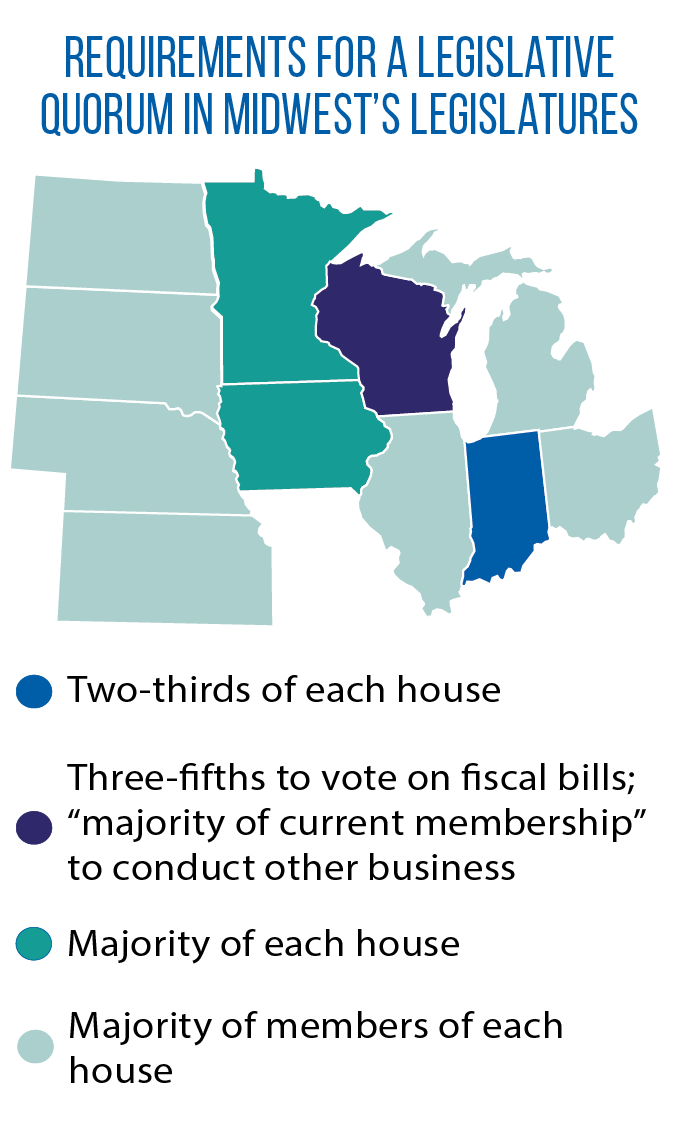Capital Closeup: A regionwide review of the requirements for a legislative quorum
Sixty-seven members of the 134-seat House present. Sixty-six members not present.
 That was the head count during the scheduled start of the 2025 legislative session in Minnesota, and this unusual situation brought attention to a common, but often little-noticed, part of state constitutions: the requirement that a certain number of legislators be in attendance to conduct business.
That was the head count during the scheduled start of the 2025 legislative session in Minnesota, and this unusual situation brought attention to a common, but often little-noticed, part of state constitutions: the requirement that a certain number of legislators be in attendance to conduct business.
With the exception of Indiana, as well as Wisconsin in some instances, states in the Midwest tie their quorum threshold to a simple majority. At issue in Minnesota, though, was this: What exactly constitutes a majority?
The Minnesota House has 134 seats, but at the start of the year, one seat was vacant until a special election could be held. That left the House with 67 Republicans and 66 Democrats, and the latter were all staying away from the chamber amid partisan disputes over power-sharing arrangements and a contested House election. (The partisan makeup entering session looked to be 67-67, but a victorious Democrat candidate resigned after a court found him ineligible to serve because he did not live in the district, thus creating the temporary vacancy.)
 According to the Minnesota Constitution, “A majority of each house constitutes a quorum.” Citing this language, the state Supreme Court ruled that the threshold for a quorum in the House is 68 — no matter the actual number of legislators in office at the time:
According to the Minnesota Constitution, “A majority of each house constitutes a quorum.” Citing this language, the state Supreme Court ruled that the threshold for a quorum in the House is 68 — no matter the actual number of legislators in office at the time:
“Vacancies do not reduce the number required for a majority of each house to constitute a quorum. By statute, the total number of seats in the Minnesota House of Representatives is 134 seats.”
Iowa also has this “majority of each house” language. The constitutions in most other Midwestern states have slightly different wording that tie the quorum threshold to the “majority of elected members” of each chamber.
Indiana is one of only a few states in the nation where two-thirds of the members must be present for a legislative quorum. In Wisconsin, three-fifths of the members must be present for a chamber to pass bills on taxes, spending or other fiscal matters. Last decade, those two states made national news due to walkouts by members of the minority party (Indiana House and Wisconsin Senate) that prevented quorums. More recently, the Michigan House could not reach a quorum at the end of its 2024 session.
Every Midwestern state has at least general language (in the constitution or elsewhere) to compel the attendance of absent legislators and to allow a chamber to impose penalties of its choosing on those members. As one example, legislative rules in the Kansas House spell out that “reprimand, censure or expulsion may be imposed.” Indiana legislators had to pay fines because of their walkout in 2011.
In Michigan, The Detroit News reports, the lack of a quorum in late 2024 prompted the speaker to issue a “call of the House,” a legislative rule that calls for a closing of the chamber doors, a requirement that present members not leave, and a dispatching of the sergeant at arms to retrieve the absent members. Despite the call, the absent members in Michigan did not return and a quorum was not reached.
Legislative rules in most Midwestern states provide for a “call of the house or senate,” if a certain number of lawmakers in attendance ask vote for it.
Capital Closeup is an ongoing series of CSG Midwest articles focusing on institutional issues in state governments and legislatures.
Constitutional language on thresholds for legislative quorum
Illinois
“A majority of the members elected to each house constitutes a quorum.”
Indiana
“Two-thirds of each House shall constitute a quorum to do business.”
Iowa
“A majority of each house shall constitute a quorum to transact business.”
Kansas
“A majority of the members then elected (or appointed) and qualified of the house of representatives or the senate shall constitute a quorum of that house.”
Michigan
“A majority of the members elected to and serving in each house shall constitute a quorum to do business.”
Minnesota
“A majority of each house constitutes a quorum to transact business.”
Nebraska
“A majority of the members elected to the Legislature shall constitute a quorum.”
North Dakota
“A majority of the members elected to each house constitutes a quorum.”
Ohio
“A majority of all the members elected to each house shall be a quorum to do business.”
South Dakota
“A majority of the members of each house shall constitute a quorum.”
Wisconsin
“A majority of each [house] shall constitute a quorum to do business.”
Note: Rules of the Wisconsin Assembly and Senate provide further clarity on the quorum requirement
- Assembly: “A majority of the current membership constitutes a quorum for the transaction of business.”
- Senate: “A majority of the membership presently serving must be present to constitute a quorum for the transaction of business.”
Three-fifths quorum requirement for votes on fiscal bills
“On the passage in either house of the legislature of any law which imposes, continues or renews a tax, or creates a debt or charge, or makes, continues or renews an appropriation of public or trust money, or releases, discharges or commutes a claim or demand of the state, the question shall be taken by yeas and nays, which shall be duly entered on the journal; and three-fifths of all the members elected to such house shall in all such cases be required to constitute a quorum therein.”